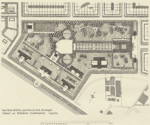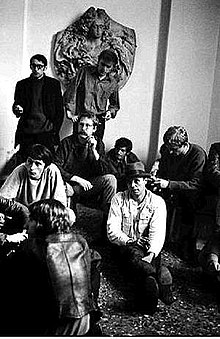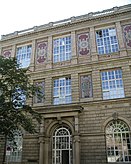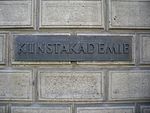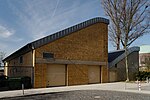Art Academy Düsseldorf
| Art Academy Düsseldorf | |
|---|---|

|
|
| founding | 1773 |
| Sponsorship | state |
| place | Dusseldorf |
| state | North Rhine-Westphalia |
| country | Germany |
| Rector | Karl-Heinz Petzinka |
| Students | 608 (WS 2012/13) |
| Professors | 35 |
| Website | www.kunstakademie-duesseldorf.de |
The Art Academy Düsseldorf is the state art academy in the North Rhine-Westphalian state capital Düsseldorf .
She and her predecessors, the oldest of which was the Lambert Krahes drawing school , founded around 1762, gave birth to significant influences and artistic personalities in terms of art history, such as those of the Düsseldorf School of Painting , with whom she succeeded in becoming an internationally renowned art academy in the 19th century.

Another high phase of the art college is the period from the end of the 1950s to the end of the 1970s, when circles around protagonists such as Joseph Beuys , Heinz Mack , Otto Piene , Gerhard Richter and Günther Uecker - with ideas and movements such as German Pop , ZERO and Fluxus , with the expanded concept of art and the concept of social sculpture - initiated spectacular actions and discourses and thus influenced the art world as well as the West German student movement of the 1960s and the 68 movement . Since the 1990s, the Düsseldorf Photo School of Artistic Photography by Bernd and Hilla Becher and their students, such as Andreas Gursky , Candida Höfer , Axel Hütte , Thomas Ruff , Jörg Sasse and Thomas Struth , have also been particularly valued . Some works by professors and graduates of the art academy achieved top prices on the art market; the world's highest price to date for a single work by a living artist was achieved in 2010 for the abstract painting 809-4 by Gerhard Richter from 1994 .
The main building at Eiskellerstraße 1 in Düsseldorf- Altstadt is an important neo-Renaissance building in Germany. Chiseled in front of the entrance stairs is the academy's claim, coined by Irmin Kamp : “Only the best for our students” . The academy's library is located on the first floor of an outbuilding at the Reuterkaserne .
history
The beginnings from 1773
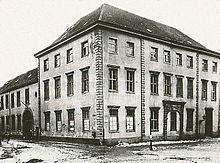



The art academy emerged in 1773 as the “ Electoral Palatinate Academy of Painters, Sculpture and Architecture” from the drawing school founded by Lambert Krahe (1712–1790) around 1762 . Around 1800 it was named "Academy of Fine Arts in Düsseldorf". Due to a lack of financial resources, the institute, which under its director Johann Peter Langer had to move from the Palais Hondheim to the former Düsseldorf Franciscan monastery on Schulstrasse , experienced a decline after 1806, the time of the Grand Duchy of Berg . In the end there were only three teachers left, the academy inspector Lambert Cornelius (1778–1823), the architect Karl Friedrich Schäffer and the engraver Ernst Carl Gottlieb Thelott .
Because the famous Düsseldorf picture gallery of the electoral house Pfalz-Neuburg was transported from Düsseldorf to Munich in 1805/1806 in the course of a country swap in which the Kingdom of Prussia had also participated, and because Düsseldorf had lost its capital function when it was incorporated into the Kingdom of Prussia , the Prussian government decided to re-establish the old academy as the Royal Prussian Art Academy as compensation . It was founded by Friedrich Wilhelm III. on March 9, 1819. The establishment is interpreted as a "reorganization of the Düsseldorf Academy" and as an "instrument of a Prussian cultural policy extending into the provinces ", the aim of which was to respect the cultural peculiarities of the Rhineland on the one hand, and to bond with Berlin on the other to guarantee. Peter von Cornelius (1783–1867), who had received his training from his father, the painter and gallery inspector Johann Christian Aloys Cornelius (1748–1800), was appointed as the first director on October 1, 1819 , on the recommendation of Barthold Georg Niebuhrs lived among the brothers of Luke in Rome . Teaching began in 1822. Cornelius placed the art of drawing and monumental painting in the foreground.
From 1821 until the fire in 1872, the art academy was located in the gallery building of the former electoral palace . The library, apartments and work rooms were housed on the ground floor. The professors' studios were on the first floor. Further work rooms and the landscape class room were on the second floor.
As early as 1824 Cornelius went with many of his students to the Munich Art Academy , where his admirer, the Bavarian Crown Prince Ludwig , had offered him better opportunities to develop monumental painting and a significantly higher salary as a director. After a period of uncertainty, Friedrich Wilhelm von Schadow (1788–1862) came from Berlin in 1826 as the new director. Some of his Berlin students joined him and also settled in Düsseldorf. The Prussian minister of culture, Karl vom Stein zum Altenstein , had chosen Schadow as a well-known portraitist with the consideration that under the conditions of the rising bourgeois society, for the painters to be trained at the art academy, jobs in particular in portrait and panel painting would arise. Under Schadow's aegis (until 1859) the academy developed into an institution of international standing. Since the 1830s, it has been associated with the concept of the Düsseldorf School of Painting , which extended beyond the actual circle of academy teachers and students. Landscape painting in particular , but also the genre , enjoyed an excellent reputation; numerous painters from Scandinavia, Russia and the United States of America came to Düsseldorf for training. Schadow introduced a training system based on the principle of the master class . After a basic or elementary class, in which the copying of drawings and later the copying of casts of human body parts was learned, the preparatory class followed. In this, the students worked on whole plaster casts as well as on nature. Execution of own designs and participation in the work of their master followed in the top class, the master class, which was reserved for particularly talented students.
New building at the security harbor
After the fire of Düsseldorf residential palace in which the newly founded Academy was initially housed a former was from 1875 to 1879 for her on grounds security port on the northern edge of Düsseldorf's Old Town , designed by Hermann Riffart a new building in historicist forms of Italian Renaissance built. Until the building was completed , the academy's teachers stayed in the remnants of the building next to the fire site, the picture gallery , or in the so-called “Wunderbau”, built by Friedrich Gerhardt , the studio building on Pempelforter Strasse 80 in the east of the city October 1879 the academy was inaugurated with a ceremony.
With the founding of the German Empire there were activities that brought about a second boom in the upswing of the academy, especially under the Prussian Minister of Education, Adalbert Falk . In the sense of Prussia Germany and Wilhelminism , monumental art took a privileged position.
In the 1890s, the boom after the founder crash , the Royal Art Academy at the Rhine Bridge signed Karl Janssen for the sculptors. He managed to get the graduates of the Royal Art Academy in Düsseldorf noticed in the art scene.
After the First World War , the classes for stage design (lecturer Georg Hacker ) and for printmaking were established. On April 1, 1919, under the aegis of Fritz Roebers , the art academy was merged with essential parts of the Düsseldorf School of Applied Arts . This school had been under the direction of Peter Behrens from 1904 to 1907 , a former student of the art academy and co-founder of the German Werkbund . He had realized new ideas for architecture and designer education. From 1908 to 1919 the arts and crafts school was under the direction of Wilhelm Kreis , who with his architecture department removed the school from the original type of arts and crafts and developed it further into an architecture college . The unification of both institutions resulted in a further programmatic opening of the art academy.
Under Wilhelm Kreis there was a class in conceptual drawing, nature studies and life drawing for women at the Kunstgewerbeschule around 1912. Since 1918, a few had the opportunity to study at the “Art College for Women”, which was located in the south wing of the Kunstpalast , which was based on post-war initiatives by emancipatory women's associations, particularly at the suggestion of the Düsseldorf Artists' Association founded in 1911 . With the affiliation of the arts and crafts school to the academy, women were now also entitled to matriculate and were admitted to study at the State Art Academy in Düsseldorf from 1921.
In the first decades of the 20th century, the art college was a crystallization core of modernity . Directions such as Rhenish Expressionism and artist associations such as Das Junge Rheinland and the Sonderbund provided new impulses and created an innovative climate. Students from the 1920s included Arno Breker and Wilhelm Lehmbruck .
"New Academy"
Fritz Roeber , director of the academy since 1908, successfully campaigned for the academy to be expanded with a new building. On the "Golzheimer Heide", which stretched south of the suburb of Stockum and north of the suburb of Golzheim between the Rhine and the district of Rath, the so-called "New Academy" or "New Art Academy" was built not far from the banks of the Rhine. Due to the First World War, the construction work for the main building dragged on until 1922/1923. The executive architect was Karl Wach . Together with Heinrich Beck, Wach received first prize for the design in 1912. When the Düsseldorf School of Applied Arts was closed in 1919 and the Academy took over five of its subjects and trained drawing teachers, the “old” art academy became even tighter. At the end of 1923 the architecture department moved to the “New Art Academy”. The realization of outbuildings and the gardens in the sense of the original overall planning by Wach and Beck failed due to financial resources. From 1929 the rooms were rented to artists as studios.
In 1936, the main building of the “New Art Academy” at Menzelstrasse 16 (named after Adolph von Menzel , ran from Grünewaldstrasse to Stockumer Kirchstrasse), now known as the “Städtisches Atelierhaus” , was integrated into the Reich Exhibition Schaffendes Volk and formed under the name “Haus der Deutschen Arbeitsfront "the main building and the point de vue of the main axis" Street of Life ". The building was demolished in 1974 in favor of the Aquazoo in Nordpark . Only the rear staircase at the head of the poplar avenue has been preserved.
In this short period of time, many artists had their studios here, including Jan Thorn Prikker , Emil Fahrenkamp , Arno Breker and many more.
Karl Wach and Heinrich Beck: Draft for the main building of the Düsseldorf Art Academy , 1912, published in 1913
After 1933
In 1933 many lecturers , including the director Walter Kaesbach and twelve professors and teachers, fell victim to the Nazi purge . The art historian Kaesbach was described by the “Düsseldorfer Volksparole” as one of those elements that stood in the way of German culture. He was accused of having served “art decomposition”, “Bolshevism” and “separatism” and allowed everything in his rooms, except for German art. Julius Paul Junghanns initially took over the management until October 25, 1933, when the Dortmund architect Peter Grund was entrusted with the representation of the Academy's director's business. The reason was the first architect to take over the management of the academy. In December 1933, Grund was appointed provisional head of the Rhineland region of the Reich Chamber of Fine Arts , and in June 1934 he was appointed full director of the academy.
During this time, in addition to Kaesbach, at least 14 of the approximately 29 teachers had to leave the academy, including Paul Klee , Ewald Mataré , Heinrich Campendonk , Karl Hofer and Werner Heuser .
In July 1933, a few months after joining the NSDAP , Franz Radziwill was appointed professor of fine art, an office which he held until 1935, when he was accused of having painted "degenerate" pictures during the Weimar period . With party-compliant teachers such as Friedrich Erhard Haag , non-civil servant associate professor for general hygiene, racial hygiene and bacteriology, who taught the subject of " racial studies" from May 1934 , the staff was increased.
The next few years at the academy were marked by National Socialist art , such as blood and soil ties and strong anti-individualism. Werner Peiner's professorship for monumental painting was relocated to Kronenburg in the Eifel, where the Hermann Göring Master School for Painting was founded , from which the GDR state artist Willi Sitte emerged . The purpose-built building was designed by Emil Fahrenkamp , who took over the acting management of the academy in July 1937.
After 1945


After the war, the initial situation for the resumption of teaching proved to be extremely unfavorable: On March 14 and 21, 1945, bombs hit the academy building for the second and last time, and all the ceilings in the eastern wing collapsed. But the academy near the Oberkassel Bridge, built in the style of the Italian Renaissance, was badly damaged more by artillery fire than by bombing ; only five of 90 rooms could be used. The British military authorities responsible for the province of North Rhine-Westphalia after the end of the war , with the responsible Lieutenant Colonel Henry James Walker, had a great interest in the normalization of public life more quickly and insisted on the academy reopening quickly despite the desolate spatial situation. Ewald Mataré , who was appointed acting director in 1945, only wanted to reopen the academy with suitable teachers. that is, he did not want to let former Nazis continue teaching. The government refused to go along with his efforts and simply left the directors out of office. In 1945 Werner Heuser was recalled to the academy and took over the office of director (1946–1949) and laid the foundation stone for the reconstruction of the building and the teaching facility, which was completed under his successor Heinrich Kamps .
The official opening, the first of an art academy in West Germany, took place on January 31, 1946. The college consisted of the three Mataré, Heuser and Kamps, who were dismissed between 1929 and 1938 and reappointed in 1945, as well as the following teachers , some of whom were only appointed in the Third Reich : Fritz Becker , Paul Bindel , Otto Coester , Joseph Enseling , Wilhelm Herberholz , Josef Mages , Jakob Heinrich Schmidt , Wilhelm Schmurr and Walter von Wecus . “The departure of the predominantly no longer young teachers in the staff was not a stormy one and remained rather cautious, often noticeably carried by the desire to finally be able to freely communicate and teach that which one had always been convinced of. Even a teacher like Mataré did not stand out for the audacity of artistic innovations, but for the breadth of positions that he allowed in his class. "
Students of this time included Mataré's master class students Joseph Beuys , Erwin Heerich and Günter Grass , who immortalized his fellow student Herbert Zangs in the novel The Tin Drum as "Lanke the painter".
In 1947 Theo Champion , Otto Pankok , Walter Köngeter and Hans Schwippert were appointed.
In 1958 the studio building to the west of the main building was completed . In the following year Karl Otto Götz was appointed to the academy, from whose class the painters Gerhard Richter , Gotthard Graubner and Sigmar Polke emerged .
In the turbulent 1960s and 1970s ( German pop , '68 movement and punk started in Düsseldorf), the academy experienced an intense debate through many Fluxus events and activities , such as the Festum Fluxorum Fluxus festival on March 2nd and 3rd. February 1963, the performance Infiltration Homogeneous for concert grand pianos on July 28, 1966 or the founding of an organization for direct democracy by referendum on June 19, 1971. There were also major conflicts between professors at the university and Joseph Beuys, against whom a manifesto was even drawn up has been. As Minister for Science and Research, Johannes Rau had a legal dispute with Beuys about his dismissal, which had taken place because Beuys had occupied the secretariat together with rejected students. The future rector Markus Lüpertz was expelled from the academy in the 1960s.
There are still legends surrounding the Düsseldorf Academy with its impressive building and huge studios, for example the legendary room 20, in which the artists Katharina Sieverding , Blinky Palermo , Imi Knoebel and Jörg Immendorff worked under Beuys , before Knoebel, Immendorff and Palermo claimed room 19 for themselves. A similar starting points of artistic trends was the photo class of Bernd Becher with the students Andreas Gursky , Candida Höfer , Axel Hütte , Thomas Ruff and Thomas Struth . Bernd Becher became the holder of the chair for photography in 1976 at the suggestion of Norbert Kricke. He was followed by Jeff Wall in 1999 and Thomas Ruff in 2000.
Other important teachers after the Second World War were Klaus Rinke with the master students Reinhard Mucha and Fritz Schwegler , who studied with Thomas Demand , Gregor Schneider , Thomas Schütte and Katharina Fritsch , among others , Alfonso Hüppi with a large number of interesting students such as Dirk Skreber and Corinne Wasmuht and the theorist Oswald Wiener .
In the 1980s there was a cultural-political initiative of the state parliament, according to which the Cologne Werkschulen (today: Art Academy for Media Cologne ) were to be run together with the Münster Art Academy, founded in 1971, as a subdivision of the Düsseldorf Art Academy.
In the academy there were or are art-historically relevant works such as the Fettecke by Joseph Beuys in room 3 (today the professor's room), Imi Knoebel's room 19 (whereabouts: Dia: Beacon , New York), Gerhard Merz's installation of a skylight in room 301 in the north tower of the Academy and a work by Klaus Rinke consisting of cacti . Among other things, this has to do with the tradition of not only providing the professors with classrooms, but also with their own atelier.
today
The concept of the course is considered to be one of the world's most liberal and committed to artistic thinking. Currently teaching at the academy is a divergent and international professorship with Peter Doig , Richard Deacon , Rebecca Warren ( Great Britain ), Rita McBride and Christopher Williams (both USA ), Siegfried Anzinger , Herbert Brandl and Martin Gostner (all Austria ), Tal R ( Denmark / Israel ), Didier Vermeiren ( Belgium ) and the German artists, Reinhold Braun , Andreas Schulze , Andreas Gursky , Eberhard Havekost , Katharina Fritsch , Tomma Abts , Marcel Odenbach , Hubert Kiecol , Max Dudler and Thomas Grünfeld (selection). Durs Grünbein and Siegfried Gohr were appointed in the field of art-related sciences .
Every year at the end of the winter semester, the academy invites you to take a tour . All classes present their artistic work to the public. The qualitative level ranges from the study to the early masterpiece.
The so-called academy gallery has existed in the building of the former arts and crafts school on Burgplatz since 2005 . It offers the works of the professors of the art academy and their former students exhibition space and is intended to build up a collection of the art academy in the long term. The graduates of the Düsseldorf Photo School celebrate great success . Andreas Gursky , student of Bernd and Hilla Becher , became a professor at the academy himself.
In August 2017, Karl-Heinz Petzinka became the new rector, who had previously been the artistic director of RUHR.2010 - European Capital of Culture .
Tour 2018
House Reuterkaserne 1 (adjoining building of the art academy)
study graduation
The course concludes with the academy letter ( diploma ) or the state examination. Both degrees can be awarded a master's degree by the respective professor .
In the art-related sciences there is also the option of a full doctorate .
Departments
The range of courses is divided into the fields of art and art-related sciences, which in turn are subdivided as follows:
-
art
- Architecture (architecture)
- sculpture
- Stage design
- Design, typography and book art
- Film and video
- free art
- Integration of fine arts and architecture
- painting
- Painting and graphics
- Orientation area
- photograph
- Art related sciences
- Art history
- philosophy
- pedagogy
- Didactics of the fine arts
- sociology
- Poetics and artistic aesthetics
- Art and the public
- Architectural theory and history
workshops
In the academy there are professional workshops with artistically and technically trained workshop managers for:
- Printmaking
- photography
- Plaster molding
- Wood carving
- Woodworking
- Ceramics
- Art foundry
- plastic
- Painting technique
- Metalworking
- Stone carving
- Video art
Directors and Rectors
The North Rhine-Westphalia Art Universities Act of October 20, 1987 (Law on Art Universities in the State of North Rhine-Westphalia) reorganized the structure and organization of the art universities in North Rhine-Westphalia. The official title of the head of the university was changed from director to rector . The heads of the university were:
|
|
Well-known professors and students
|
A.
B.
C.
D.
E.
F.
G
H
I.
J
K
|
L.
M.
N
O
P
R.
S.
T
U
V
W.
Z
|
literature
- Kunstakademie Düsseldorf (ed.): The history of the Kunstakademie Düsseldorf since 1945. Deutscher Kunstverlag, Berlin 2014, ISBN 978-3-422-07229-9 .
- Johannes Stüttgen : The whole belt. Beuys appeared as a teacher at the Düsseldorf Art Academy from 1967–1972 . Verlag der Buchhandlung König, Cologne 2008, ISBN 978-3-86560-306-7 .
- Heinz Peters: Wilhelm Lambert Krahe and the establishment of the art academy in Düsseldorf . In: Eduard Trier (ed.): Two hundred years of art academy in Düsseldorf . Schwann, Düsseldorf 1973, p. 1 ff.
- Rudolf Wiegmann : The Royal Art Academy in Düsseldorf. Their history, furnishings and effectiveness and the Düsseldorf artists. Buddeus, Düsseldorf 1856.
- Karl Woermann : On the history of the Düsseldorf Art Academy. Outline of their last decade and memorandum for the inauguration of the new building. Düsseldorf 1880. Digitized edition of the University and State Library Düsseldorf
- Hans Paffrath (Ed.): Lexicon of the Düsseldorf School of Painting 1819–1918. Volume 1: Abbema – Gurlitt. Published by the Kunstmuseum Düsseldorf in the Ehrenhof and by the Paffrath Gallery. Bruckmann, Munich 1997, ISBN 3-7654-3009-9 .
- Rolf Wederer, Thomas Kempas: Architectural Speculations. Drosteverlag, 1970, DNB 851010024 .
- Museum Ramboux: Replicas to visualize Christian painting in Italy from the earliest to the most artistic epoch at the Royal Art Academy in Düsseldorf. Voss, Düsseldorf 1851. Digitized edition of the University and State Library of Düsseldorf
- Ludwig Bund: The semisäcular celebration of the Royal Art Academy in Düsseldorf: in the days of June 22, 23 and 24, 1869. Budich, Düsseldorf 1870 ( digitized version )
Web links
- Website of the Art Academy Duesseldorf
- Kempis Magazine ( Memento from February 25, 2012 in the Internet Archive )
- 1946 - Reopening of the Düsseldorf Art Academy
- Finding aid 212.01.04 (Excel). List of pupils from the Düsseldorf Art Academy from the years 1830–1895 in inventory BR 0004 Düsseldorf Government Presidential Office No. 1558 to No. 1562 further developed. Additions and corrections to the last correction pass (2013) were made - e.g. Partly in coordination with the archive of the Art Academy Düsseldorf - indicated by square brackets. , at archive.nrw.de, accessed on January 24, 2017
- Artists of the Düsseldorfer Malerschule (selection, status: November 2016): Directory with almost 2500 entries provides for the first time a comprehensive overview of the artists associated with the Düsseldorfer Malerschule. Primarily the persons were recorded who studied at the art academy (KA), took private lessons (PU) or worked artistically in Düsseldorf. (PDF) , on smkp.de, accessed on January 24, 2017
Individual evidence
- ↑ Federal Statistical Office: Number of students by type of university, state and university, WS 2012/13, pp. 66–113 (accessed on November 3, 2013)
- ↑ List of the university rectors' conference on the status of universities at: hochschulkompass.de.
- ^ Irving Sandler : Art of the Postmodern Era: From the Late 1960s to the Early 1990s . Icon Editions, 1996, p. 87 ( excerpt, PDF ).
- ↑ Raya Nikkah: Gerhard Richter painting owned by Eric Clapton sells for £ 21 million - the highest price for a living artist . Article dated October 13, 2012, accessed on October 14, 2012 in the online portal of the daily newspaper The Telegraph.
- ↑ Anne Reimers: The man in Olympus . Article from October 16, 2012 in the faz.net portal , accessed on October 19, 2012.
- ↑ This is what the sculptor Irmin Kamp made during her rectorate 1982–1987. On the occasion of Klaus Staeck's appointment as visiting professor in 1986 , pupils in Ulrich Rückriem's class chiseled this slogan into pavement slabs, which were then exchanged for the old slabs laid at the entrance to the art academy in a night campaign (see Rolf Purpar: Kunststadt Düsseldorf. Objects and monuments in the cityscape 2nd edition, Grupello Verlag, Düsseldorf 2009, ISBN 978-3-89978-044-4 , p. 48).
- ^ Library of the Art Academy: University library for lecturers and students; Special library, generally accessible.
- ↑ Heinz Peters: Wilhelm Lambert Krahe and the establishment of the art academy in Düsseldorf . In: Eduard Trier (ed.): Two hundred years of art academy in Düsseldorf . Düsseldorf 1973, p. 1 ff.
- ↑ Bernd Füllner u. a .: Düsseldorf as the city of art 1815–1850. In: Documentation on the history of the city of Düsseldorf. Pedagogical Institute of the State Capital Düsseldorf, Düsseldorf 1987, Volume 10, p. 5.
- ^ Helmut Börsch-Supan : The early work of Wilhelm von Schadow and the Berlin requirements of the Düsseldorf school . In: Wend von Kalnein (Ed.): The Düsseldorf School of Painting . Verlag Philipp von Zabern, Mainz 1979, ISBN 3-8053-0409-9 , p. 65.
- ^ Hugo Weidenhaupt: From the French to the Prussian times (1806-1856). In: Hugo Weidenhaupt (Ed.): Düsseldorf. History from the origins to the 20th century. Schwann in Patmos Verlag, Düsseldorf 1988, ISBN 3-491-34222-8 , Volume 2, p. 397.
- ↑ Bernd Füllner u. a .: Düsseldorf as the city of art 1815–1850. 1987, p. 7.
- ^ Hugo Weidenhaupt: From the French to the Prussian times (1806-1856). 1988, p. 398.
- ^ Friedrich Schaarschmidt: On the history of Düsseldorf art, especially in the XIX. Century , Art Association for the Rhineland and Westphalia, 1902, p. 293 .
- ^ Karl Woermann: On the history of the Düsseldorf art academy. , Voss, Düsseldorf, 1880 in digital form: second division. The opening ceremony of the new building of the Düsseldorf Art Academy on October 20, 1879.
- ↑ Ekkehard Mai: The German art academies in the 19th century: Artist training between tradition and avant-garde , Böhlau, Cologne Weimar Vienna, 2010, ISBN 978-3-412-20498-3 , p. 299ff
- ^ Jutta Dresch: Karl Janssen and the Düsseldorf School of Sculpture . Revised dissertation from the summer of 1987. Triltsch Verlag, Düsseldorf 1989, ISBN 3-7998-0055-7 , p. 59-61 .
- ^ Richard Klapheck : Architecture and Art Academy . Düsseldorf 1919, p. 244 ( file in PDF ).
- ↑ Ekkehard Mai : The German art academies in the 19th century. Artist training between tradition and avant-garde . Böhlau Verlag, Cologne / Weimar / Vienna 2010, ISBN 978-3-412-20498-3 , p. 373.
- ↑ Dawn Leach: Opening speech for the exhibition "Women Artists in the Nazi Era" , typewritten lecture, Düsseldorf 2005, p. 1.
- ^ Menzelstrasse: New building of the state art academy , in officially commissioned address book of the city of Düsseldorf, 1924, p. 168.
- ^ V. the new building of the art academy , in address book of the city of Düsseldorf 1938. The Rhine in the planning and architecture of the city of Düsseldorf, pp. XXII, XXIII, XXIV.
- ↑ 25 October 1933: Introduction of the new director of the art academy, Prof. Peter Grund, by the district president. Notable occurrences from October 1, 1933 to October 1, 1934, in the address book of the city of Düsseldorf, 1935.
- ↑ December 12, 1933: Appointment of the director of the art academy, Prof. Peter Grund, as provisional head of the "Rhineland" state of the Reich Chamber of Fine Arts. Notable occurrences from October 1, 1933 to October 1, 1934, in the address book of the city of Düsseldorf, 1935.
- ↑ June 15, 1934: Prof. Grund appointed director of the State Art Academy. .
- ↑ Racial Studies: Prof. Dr. med. Haag , in 10th State Art Academy, Address Book of the City of Düsseldorf, 1935, Part One Authorities Directory, p. 11.
- ↑ Dr. Haag, Friedrich Erhard, General Hygiene, Racial Hygiene a. Bacteriology, Associate Professor , in the address book of the city of Düsseldorf, 1938, first part, NSDAP offices, p. 20.
- ^ Wieland Koenig (preface), Werner Alberg (adaptation): Düsseldorfer Kunstszene 1933–1945, City of Düsseldorf. City Museum, 1987, ISBN 3-926895-00-4 .
- ↑ July 30, 1937: Prof. Fahrenkamp took over the provisional management of the Art Academy. Notable occurrences from October 1, 1936 to September 30, 1937, in the address book of the city of Düsseldorf, 1938.
- ^ Annual report of the Art Academy 1945 to 1947, Verlag A. Bagel 1947.
- ↑ Düsseldorfer Stadtchronik 1945: November 24, 1945 Appointment of the sculptor Ewald Mataré as acting director of the State Art Academy in Düsseldorf.
- ↑ Lothar Romain : Don't stay with the old! The Düsseldorf Art Academy after the war Source: From the rubble. New beginning and continuity. Art and culture in the Rhineland and Westphalia 1945–1952, Klaus Honnef and Hans M. Schmidt (eds.), Cologne, 1985, pp. 419 to 421.
- ↑ Rita McBride becomes the new Rector of the Düsseldorf Art Academy. In: derwesten.de. June 3, 2013, accessed May 1, 2020 .
- ↑ www.wz.de: Petzinka elected as the new rector of the Düsseldorf Art Academy , April 24, 2017.
- ↑ Christina zu Mecklenburg: Adventurous journey through a residential landscape . In: General-Anzeiger (Bonn) of November 1, 2002.
- ↑ https://www.thyes.com/
Coordinates: 51 ° 13 ′ 49.9 ″ N , 6 ° 46 ′ 25.1 ″ E





